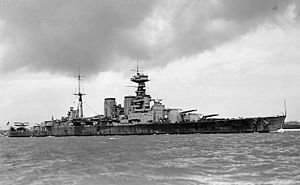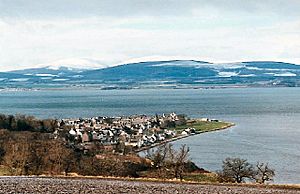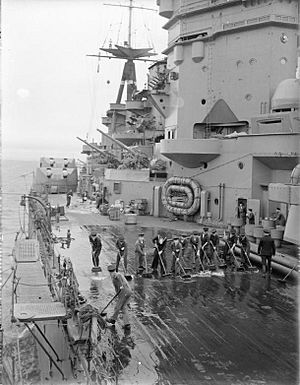Invergordon Mutiny facts for kids
The Invergordon Mutiny was a protest by about 1,000 sailors in the British Atlantic Fleet. It happened on September 15-16, 1931. For two days, ships of the Royal Navy at Invergordon, Scotland, were in open mutiny. This was a rare military strike in British history.
This event caused a big stir in London's financial markets. It made Britain's money problems even worse. The country was forced to stop using the Gold Standard on September 21, 1931. The Gold Standard was a system where a country's money value was directly linked to gold.
Contents
Why the Sailors Protested: Pay Cuts
In September 1931, Britain was going through the Great Depression. This was a time of serious economic hardship. To try and fix the economy, the new National Government decided to cut public spending. This meant less money for government workers.
For the Navy, this meant a 10% pay cut for officers and experienced sailors. However, younger sailors who had joined before 1925 faced a much bigger cut. Their pay was reduced by 25%. Many sailors felt this was very unfair. They also felt let down by the government, especially by Ramsay MacDonald, who had formed a new government with the Conservatives.
Sailors of the Atlantic Fleet arrived at Invergordon in Scotland on September 11. They learned about the pay cuts from newspapers. Some reports even suggested that all sailors would get a 25% cut. This news was a big shock. On September 12, the Admiralty (the Navy's leadership) confirmed the pay cuts.
By September 13, sailors were already upset. The temporary commander of the fleet, Rear-Admiral Wilfred Tomkinson, received a letter from the Admiralty explaining the cuts. He ordered commanders to share this information with their crews. But many ships did not get the letter in time. By then, many sailors were already planning to protest.
Early Signs of Trouble
Ten warships arrived at Invergordon on September 11. These included Hood, Rodney, and Valiant. After arriving, sailors read about the pay cuts in newspapers. On the night of September 12, a group of sailors met on land. They decided to organize a strike. They even sang "The Red Flag", a song linked to workers' rights.
The next evening, some sailors gave speeches at the canteen ashore. They spoke out against the pay cuts. The officer on patrol reported this and asked for more help. The canteen was closed early, and the sailors left peacefully. However, more speeches were made at the pier. Rear-Admiral Tomkinson decided not to punish anyone for these early protests. He reported the events to the Admiralty.
On September 14, more ships arrived. That evening, Tomkinson was told about more protests at the canteen. Sailors were being noisy, and some civilians were reportedly with them. The sailors returned to their ships, but many continued protesting on deck. Tomkinson told the Admiralty that the main problem seemed to be the unfair 25% pay cut for some sailors. He asked commanders to report on the situation.
The reports showed that sailors on some big ships like Hood, Rodney, Valiant, and Nelson planned to stop their ships from sailing the next day. The protests were mainly from younger sailors. They were not angry at their officers, just about the pay cuts. Tomkinson thought about canceling the next day's exercises. But he decided to go ahead, hoping that one ship, Repulse, would follow orders and calm things down.
The Mutiny Begins
On the morning of September 15, Repulse sailed on time. But sailors on the other four large ships refused to follow orders. On Hood and Nelson, crews did their normal harbor duties but would not go to sea. On Valiant and Rodney, crews only did essential tasks like safety patrols. They did this without taking orders from their officers.
Throughout the day, crowds of cheering sailors gathered on the decks of most ships. On Rodney, a piano was brought on deck, and songs were sung. Officers tried to give orders through loudspeakers, but they were ignored. Valiant tried to leave the harbor with only a few men working, but it could not move. On Tomkinson's own ship, Hood, crew members stopped officers from preparing the ship to sail. Even Royal Marines, who were supposed to keep order, joined the protest.

Tomkinson stopped all exercises and canceled all leave. He ordered investigations into the complaints. He also told Warspite, Malaya, and Repulse to return to the harbor.
In the afternoon, Tomkinson again told the Admiralty about the serious situation. He said he did not think order could be restored until a decision was made about the pay. He finally received a reply at 8:00 PM. The Admiralty told him to inform sailors that their current pay would stay until the end of the month. They also said they expected the men to do their duty. The Admiralty claimed the cut was only 10%, but this ignored the 25% cut for some sailors. Tomkinson replied that it was impossible to continue exercises. The protest was spreading. Sailors on Norfolk and Adventure had joined the strike. There were also reports that some experienced petty officers were starting to join the protest.
In the early hours of September 16, Tomkinson told the Fleet that Admiral Colvin had gone to the Admiralty to explain the sailors' complaints in person. He asked all crews to return to duty.
On the morning of September 16, Tomkinson received the last of the complaints. He sent these to the Admiralty. After talking with other admirals, he said he believed the mutiny would get worse unless a quick change was made. He suggested that younger sailors who had joined before 1925 should only have a 10% pay cut. He also asked for Admiralty members to visit Invergordon. Soon after, he was told that the Cabinet (the government's main decision-making group) was discussing the matter. Meanwhile, the crew of Hood had stopped all but essential duties. Some sailors even threatened to damage machinery.
In the afternoon, the Admiralty ordered all ships to return to their home ports immediately. Tomkinson told the ships to leave as soon as possible. He also gave officers and crew with families in Invergordon permission to say goodbye. That night, all ships sailed from Invergordon as ordered.
What Happened Next
When reporting on the mutiny, Tomkinson said that the crews had remained respectful to their officers. He also said that officers had tried their best to explain the government's reasons for the pay cut. He concluded that the mutiny was mainly caused by the unfair 25% cut for younger sailors. He believed their complaint was fair. He also thought that using force would have made the situation much worse.
The Cabinet agreed with Tomkinson's suggestion. Sailors who had joined before 1925 would now only face a 10% pay cut, like everyone else. However, it was made clear that any future protests would be severely punished. Some of the protest leaders were put in jail. About 200 sailors were removed from the Navy. Another 200 sailors from other parts of the Navy were also removed, accused of trying to start similar protests. The Admiralty blamed Tomkinson for the mutiny, saying he should have punished the protesters earlier.
The mutiny caused a panic on the London Stock Exchange (Britain's main stock market). People rushed to exchange their British pounds for gold, which made Britain's money problems even worse. This forced Britain to stop using the Gold Standard on September 21, 1931.
Len Wincott, one of the mutiny leaders, moved to the USSR in 1934. He survived the Siege of Leningrad during World War II. But in 1946, he was sent to a prison camp (Gulag) after being accused of being a British spy. He was imprisoned for over ten years. After his release in the 1950s, he became friends with Donald MacLean in Moscow. Another leader, Navy boxer Fred Copeman, later led a British group in the Spanish Civil War.
See also
- Spithead and Nore mutinies
- HNLMS De Zeven Provinciën (1909)#Mutiny
- Royal Indian Navy Mutiny
- Chilean naval mutiny of 1931
- Kronstadt rebellion
- Wilhelmshaven mutiny
- Revolt of the Lash
- Royal Canadian Navy mutinies 1949
|




